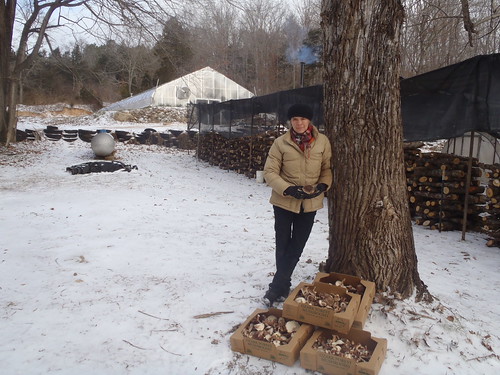
Imagine an open field of vegetables and greens, exposed to the sun and the wind on the outskirts of your town. Now imagine a row of trees sheltering the crops from hot dry winds and producing more marketable melons than in open fields; more snap beans earlier and later in the season when prices are higher.
Now imagine a row of shrubs next to the trees bearing fresh fruits such as plums, chokecherries, and elderberries that become jams, jellies, pies, and wines. Imagine another row of trees producing a bounty of healthy and delicious nuts such as black walnuts, pecans, and chestnuts.
There may be woods nearby, thick with dense undergrowth. Imagine these woods providing income for generations to come, for thousands of forest landowners. The bounty of foods these woods can produce include delectable mushrooms and tasty ramps (a wild leek); materials such as bittersweet vine and curly willow for creating home decorations; and medicinals such as ginseng and goldenseal.
Nicola Macpherson is the owner of Ozark Forest Mushrooms in Salem, Missouri. With the assistance of her state’s forestry agency, the Missouri Department of Conservation, a Forest Stewardship Plan was developed that helped her business to sustainably manage the forest and produce wholesome mushroom products at the same time. Using branch wood from trees that are selectively thinned, she inoculates them with mushroom spawn and has built a profitable forest farming business in shiitake mushrooms.

“With assistance from the USDA Forest Stewardship Program, we are able to harvest a renewable supply of mushroom bed logs to grow shiitake mushrooms while at the same time keeping our Ozark forest healthy,” says Nicola.
This is agroforestry...blending trees and agriculture to enhance the sustainable production of food and other useful products while protecting our soil and water, diversifying and expanding local economies, providing wildlife habitat, and ensuring a more pleasing and healthy place to work and live. Agroforestry takes advantage of the interactive benefits from combining trees and shrubs with crops and/or livestock, and practices include alley cropping, forest farming, riparian forest buffers, silvopasture, windbreaks, and other special applications.
The USDA National Agroforestry Center is collaboration between USDA’s Forest Service and Natural Resources Conservation Service.
